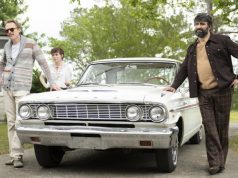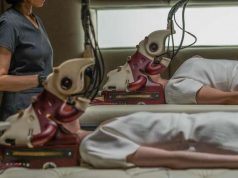In the intense opening sequence that begins “28 Days Later” and sets the tone for the rest of the film, animal-rights activists break into a London laboratory and set the test monkeys free, ignoring panicked objections from scientists who say the primates are too dangerous to be let loose. One of the monkeys bites an activist; a scientist, now out of his mind with terror, insists that now both monkey and activist must be killed.
Twenty-eight days later, a bicycle messenger named Jim (Cillian Murphy) wakes up in a hospital to find that all of London — and seemingly the entire world — has been wiped out by a virus spread by the aforementioned monkeys. The virus doesn’t kill you, though; instead, it turns you into something of a zombie, a single-mindedly murderous entity whose only desire is to attack other beings and pass the virus along.
Jim encounters a few other survivors, notably a resilient black woman named Selena (Naomie Harris), middle-aged Frank (Brendan Gleeson) and his daughter Hannah (Megan Burns). They head for a military outpost outside of Manchester in the hopes of finding survivors there, too. But in the meantime, they must avoid the “infecteds” — who, in contrast to most movie zombies, move at an alarmingly fast pace — or risk becoming infected themselves. They also must fight the twin villains of fear and despair.
Director Danny Boyle (“Trainspotting”) has crafted an outstanding sci-fi flick, with a frenetic, high-energy climax and an unceasingly inventive visual style. The film moves rhythmically through a variety of circumstances and emotions, and Boyle handles them all with confidence. The scene in which Jim discovers his parents are dead is as calmly agonizing as the attack scenes are terrifying.
Alex Garland’s script allows for humor in the bleak situation, as well as providing ample opportunities for scaring the pants off the audience. I believe this film contains the most exciting tire-changing scene in movie history; that’s not to mention the many more conventional moments in which characters’ lives are threatened, and often lost, all portrayed with eerie matter-of-factness. Then it comes down to a gripping finale in which zombies are as much a threat to our heroes as a group of panic-stricken fellow survivors are.
The film’s tone throughout is melancholic and even contemplative. Rather than simply filling the screen with mayhem (though certainly it plays a part), Boyle lets his actors act. They remain human, despite the adversity; thoughts of “What meaning does life have now?” weigh on their minds as heavily as the more immediate, logistical issues of “How do we escape from these things that want to kill us?” The film is endlessly suspenseful, but it is more than thrilling; it’s satisfying and whole.
This is indisputably a genre picture, an apocalyptic thriller with social commentary built in — “People kill each other all the time; this is nothing new” — but it is also a surprisingly human film with some subtle, life-affirming strokes. Witness the scene in which the disparate band of survivors locates a supermarket and gleefully chooses their favorite foods. Witness the quiet moment on the way to Manchester when Jim sticks his hand out the window of the speeding car. Witness the burgeoning relationship between Jim and Selena — obligatory, maybe, but portrayed convincingly. Even in the worst of times, people are people. They like tasty foods, they think it’s fun to put their hands out the windows of fast-moving automobiles, and they like to fall in love. “Staying alive is as good as it gets,” one sour character says. The film makes the point that this is not true, that there is more to life than merely surviving. As terrific as “28 Days Later” is as a zombie flick, it’s just as good as a tribute to the indomitability of the human spirit.
A (1 hr., 48 min.; )





